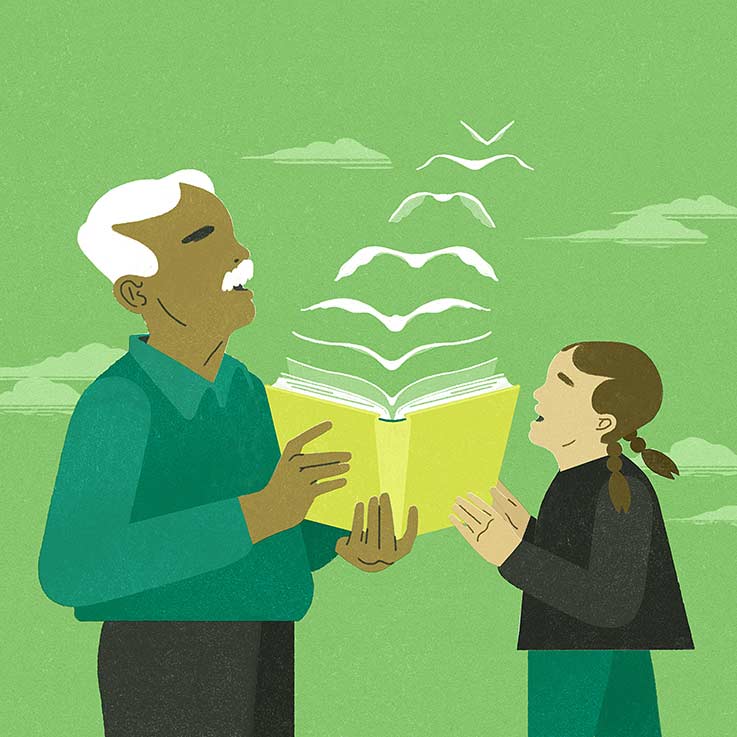
A Third Space of Proximity
A Third Space of Proximity
How a college-in-prison nonprofit continues to teach during prison quarantine.
By Sarah Higinbotham & Jamil Zainaldin Oct. 12, 2020
(Photo by iStock/eddiesimages)
“It is in proximity,” as public interest lawyer Bryan Stevenson says, “that we understand things we cannot understand from a distance.” For the last 12 years, college faculty working with the nonprofit Common Good Atlanta have worked to foster proximity between Georgia’s prisons and Georgia’s universities, drawing more than 100 volunteer professors from nine southern universities to teach courses on literature, history, science, psychology, philosophy, art, and writing inside both men’s and women’s prisons five days a week. When students are released, they return to their families and communities having read widely, refined their writing and speaking skills, and perhaps most importantly, having been accepted as intellectual and social peers.
Until COVID-19, proximity was key to the work. Professors leave their college campuses, drive to remote prisons, navigate security checkpoints, and enter into deep, lively, intellectual discussions with men and women who are otherwise isolated from society. Proximity is part of how the program affirms their human dignity: “When college faculty walk into our classroom and take us seriously,” writes an incarcerated student named Akeem, “they remind me after seven years of incarceration how it feels to be looked at as a human being.” Likewise, many faculty members say that teaching inside prisons represents their most rewarding and fulfilling professional experiences. Our work resists insular mentalities and we reject isolation as a means of addressing social problems.
When prisons suspended all in-person programs in response to COVID-19, we had to rethink how to build proximity. Since March 10, and with no end in sight, Georgia’s prisons locked down to all volunteer and family visits. This protocol has been absolutely necessary to protect people in prisons from the virus, but it posed unique challenges for prison programs, especially given the strict security mandates surrounding internet-based communication and most forms of technology. While the pandemic has brought a technological leap forward for many students—we have transitioned to Zoom in our downtown Atlanta course for people released from prison, as have so many schools and colleges—internet connectivity within Georgia’s prisons is limited by a myriad of security procedures. People in Georgia’s prisons can only access a pay-per-email system and educational and book websites that are monitored by the state. They do not have access to live, interactive telepresence systems or even the ability to email professors. So we’ve found ourselves searching for ways to continue teaching, without access to video conferencing, recorded and uploaded lectures, or even email.
Epistolary Learning
In late March 2020, Common Good Atlanta shifted to a writing-intensive, epistolary method that has revealed surprising strengths. Each week we drop off clear plastic portfolios labeled with every student’s name, with a shared reading—a book, article, or chapter—along with a letter from the faculty site director, a letter from the teaching professor with background and analysis on the week’s reading, a writing prompt for the week, and individual feedback on their last assignment. The prison staff collects all the portfolios with the students’ responses and delivers them to the security entrance, ready to exchange. Each of our more than 70 current students inside four prisons receive specific, lengthy, narrative feedback on their writing from the previous week, often from faculty and peer tutors in addition to their professor’s feedback.
If it sounds labor-intensive, it is. The packet system requires the same investments of driving time, copying, planning, reading, and commenting on the part of dozens of volunteer college faculty—who are already adapting to pandemic protocols in their home colleges—but without any of the rewards and feedback of classroom energy. Crafting clear, meaningful, nuanced letters, thoughtful prompts, and constructive feedback in writing takes a great deal of time.
However, rather than a diluted version of the college experience, we have discovered increased investments of time have yielded dividends: The incarcerated students’ writing has grown increasingly refined, with precise evidence and analysis working together to enhance their arguments. Students participate in drafting and revision exercises with writing tutors, and those of us driving to the prisons to exchange work have found ourselves opening the portfolios in the prison parking lot, beneath guard towers and concertina-wire fences, eager to read the students’ most recent essays.
In a Philosophy course, students are prompted to answer “What does it mean to say that existence determines essence? How does this differ from the Cartesian view that the self is aa thing that thinks?”; in a world history course, students are asked to respond to Virginia v. John Brown: “John Brown’s final address to the court stands as one of the greatest examples of American oratory. Which part of the final address do you find most compelling? Why?”; and a literature class, responding to Barbara Kingsolver’s “Small Wonder,” students are asked “In mythical traditions, there are many stories about human and animal interactions that defy anything we know in the “real world” and cannot be explained rationally or by science. This story was reported as a factual account in newspapers, yet it bears a striking similarity to myth. What are some advantages of mythical accounts compared to newspaper accounts? What are some advantages of newspaper accounts compared to myth.”
By responding to the week’s questions in sustained narrative replies, students employ the skills we teach about quoting from the original text and substantiating each point with textual evidence. In return, professors often write up to 1,000-word replies, framed as letters, in which they enter fully into a conversation with the incarcerated writers, pointing out the strengths of the essays in addition to what could be refined. (As a point of comparison, this article is about 2,000 words.) But the professors are not the only ones who offer feedback: Undergraduates also read and send peer feedback in the packets, as do faculty writing instructor tutors, local writers who volunteer in our program, and graduate students. Sometimes a student will receive up to three narrative critiques of any one essay, giving them a wide audience’s perspective on their intellectual work.
The feedback is often accompanied by an additional article, chapter, or poem that the professor finds to be in conversation with the student’s ideas. When a student at an east Atlanta prison responded to Martin Luther King, Jr., one of his writing mentors, Max Blau, responded with the following letter:
Hi Matthew,
Hope you're staying safe. I'm glad I got the chance to read your essay. I appreciated the way you argued against a popular idea — that the arc of the moral universe is long but it bends toward justice. It's an idea that, as you point out, has yet to be fulfilled. And therefore, it's worth exploring.
Beyond splicing the definition of the quote, would you also be able to come with some more examples as to why the moral arc of the universe is void? Especially given that the King quote was originally adapted from a 19th-century abolitionist named Theodore Parker, who said “I do not pretend to understand the moral universe; the arc is a long one, my eye reaches but little ways; I cannot calculate the curve and complete the figure by the experience of sight; I can divine it by conscience. And from what I see I am sure it bends towards justice.”
The article I attached is a strong example of someone arguing for what was, at the time, a nontraditional idea of reparations. Through history, he was able to build a compelling argument. I believe you, too, can do this. Hopefully, this offers some inspiration.
Along with his response, the professor sent Ta-Nehisi Coates’ “The Case for Reparations.” Professors begin their letters “Dear Philosophers” or “Dear Shakespeare Scholars” and close with “Have a thoughtful week” or “Always remember that your minds are free.”
In our weekly structured correspondence with the students, we all became “epistolary learners.” Were we not like so many scholars and students throughout history, whose main medium of exchange was the letter? From ancient Greece and Rome to early modern Europe, the letter—philosophical, literary, scientific—was a crucial vehicle for long-distance intellectual disputation. For these epistolary learners, the letter was not a symbol of absence, but just the opposite: a tangible kind of presence. It was a redefined proximity, a kind of “third space” in which the professor’s written teaching mode meets the incarcerated student’s responsive emotions and intellectual ideas, likewise expressed in writing. As the first-century Roman philosopher Seneca told his addressee in one of his Moral Letters, “I never receive a letter from you without immediately being together with you.”
Communicating solely by writing has enriched the rhetorical abilities of both our students and faculty. Under normal circumstances, we have access to teaching modes such as lectures, group discussions, visual presentations, experiments, and in-classroom activities. But for the last twenty-nine weeks, constraining our communication to writing has forced us all into more creative mindsets, expanding rather than contracting our communication and learning. Our program has always sought to build a writing culture, and that culture has strengthened during the quarantine. In addition to incarcerated students receiving individual feedback on their writing from faculty, Georgia Tech’s Postdoctoral Fellows, undergraduate students from Emory’s Oxford College, and PhD students from Emory’s Mellon Public Writing Fellowship also read and responded to students’ essays. What is more, our broader community of collected students and faculty have sent more than 800 letters containing enrichment articles, poems, and notes via the U.S. mail to keep our incarcerated students connected, all coordinated by our more than 100 volunteer faculty from universities across the state.
Epistolary learning has strengthened our practice of individualized attention. We ground our teaching in the Socratic method, the question-and-answer style that engages both teacher and student in a mutual pursuit of the truth: rather than simply implanting ideas, we position ourselves as learners alongside our students. We have found packet-learning no barrier to this kind of Socratic engagement with our students. Our conversations have moved from classroom to letter. Our weekly exchanges with the students play out a dozen Socratic conversations at the same time, conversations that have become all the more valued for the deliberate and intentional pace of our communication.
And just as Thomas More wrote from the Tower of London, Nelson Mandela wrote from Robben Island, and Martin Luther King, Jr. wrote from a Birmingham Jail cell, our prison exchanges during this 21st-century disruption of COVID-19 reveal the human resilience rooted in writing that can triumph over isolation.
After COVID-19
When we can return to the prisons, our reclaimed proximity will be celebratory. Months of wearing masks and physical distancing have taught us the profound and nuanced ways that faces convey meaning. And we remain convinced that physical proximity is especially crucial in prisons, where meaningful human contact is scarce. But as with so many socially innovative programs across the world since COVID-19, we have found that the constraints imposed on our programming have led to increased creativity. In fact, the absence of shared physical space helped us define a new kind of proximity, perhaps one that can only exist in a deep, narrative writing exchange between students and their professors. A space created when people must rely solely on the mode of writing to convey emotion, meaning, and understanding. It is a space that can only be found through deep listening. Sustaining that space of listening and writing will remain crucial to our work, even when we return to in-person teaching.
“All of us have the capacity to get close to people who are suffering, close to people who have fallen down … but we can’t do it if we’re not proximate,” Bryan Stevenson says. In this strange liminal moment of history, when physical proximity threatens rather than fosters our mutual development, the resilience we have learned from our incarcerated students helped us pivot to a new kind of proximity.










